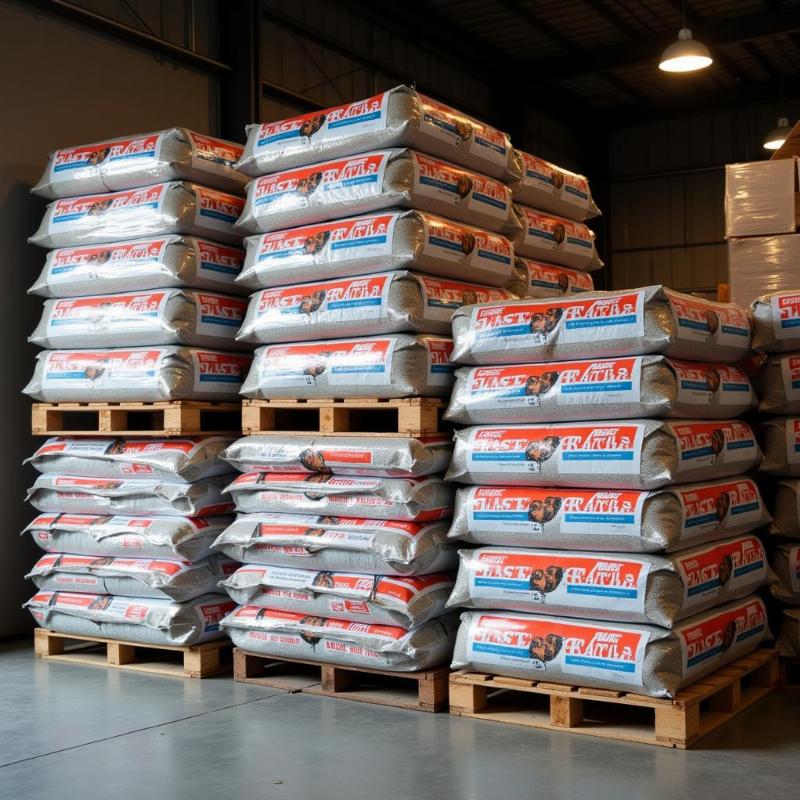Buying dog food by the pallet can be a smart move for kennels, breeders, shelters, multiple-dog households, or even savvy individual owners. It offers considerable cost savings and ensures a consistent supply of food for your canine companions. However, navigating the world of bulk dog food purchasing requires careful consideration. This guide will equip you with the essential knowledge to make informed decisions when purchasing dog food by the pallet, ensuring both your wallet and your furry friends are happy.
Understanding the Benefits and Challenges of Buying Dog Food by the Pallet
Purchasing dog food in bulk offers several advantages, primarily cost savings. Buying by the pallet significantly reduces the per-unit cost compared to smaller bags. It also eliminates frequent trips to the store, saving you time and effort. However, there are challenges to consider. Proper storage is crucial to maintain the food’s freshness and prevent spoilage. You’ll need ample dry, cool storage space. Also, ensure your dog enjoys the chosen food before committing to a large quantity.
 Bulk Dog Food Pallet Storage
Bulk Dog Food Pallet Storage
Choosing the Right Dog Food in Bulk
Selecting the appropriate dog food is paramount, regardless of quantity. Consider your dog’s breed, age, activity level, and any specific dietary needs or allergies. Research different brands and formulas. Look for high-quality ingredients, balanced nutrition, and a reputable manufacturer. Consulting with your veterinarian can provide personalized recommendations based on your dog’s individual needs.
Navigating Dog Food Formulas and Ingredients When Buying by the Pallet
Understanding dog food labels is essential. Pay close attention to the guaranteed analysis, which lists the minimum percentages of crude protein, fat, fiber, and moisture. The ingredient list provides details on the specific components of the food. Ingredients are listed in descending order by weight. Look for whole meat sources as the primary ingredients and avoid fillers like corn, wheat, and soy.
Storing and Managing a Pallet of Dog Food
Storing a pallet of dog food correctly is crucial for maintaining its quality. Store the food in a cool, dry, and well-ventilated area away from direct sunlight, moisture, and pests. The ideal temperature range is between 50°F and 70°F. Keep the original packaging intact to protect the food from contaminants. Consider using airtight containers to further protect against moisture and pests. Regularly rotate your stock, using the oldest food first.
Calculating Costs and Savings When Buying Dog Food by the Pallet
Before buying by the pallet, compare the per-unit cost to the price of smaller bags. Factor in shipping costs and any potential discounts. Consider the shelf life of the food and your dog’s consumption rate to ensure you can use the entire pallet before it expires. Use a spreadsheet to track costs and savings.
Conclusion
Buying dog food by the pallet can be an economical and convenient option for those with high dog food demands. However, careful planning and consideration are crucial. By following the guidelines outlined in this guide, you can confidently purchase dog food in bulk, ensuring your furry friends receive optimal nutrition while maximizing your savings.
FAQ
- How much space do I need to store a pallet of dog food? A standard pallet occupies approximately 48″ x 40″. Factor in additional space for maneuvering and access.
- What is the shelf life of dog food stored on a pallet? Unopened dry dog food typically has a shelf life of 12-18 months.
- How can I prevent pests from infesting my dog food pallet? Store the pallet in a clean, dry area and use airtight containers for opened bags.
- Is it safe to buy dog food by the pallet online? Yes, reputable online retailers can offer competitive prices and convenient delivery. Ensure they have proper storage and shipping procedures.
- Can I return a pallet of dog food if my dog doesn’t like it? Return policies vary by retailer. Check the seller’s policy before purchasing.
- What are the signs of spoiled dog food? Signs include a rancid smell, mold growth, insect infestation, and a change in texture or color.
- Should I consult my veterinarian before switching to a new dog food, even in bulk? Yes, it’s always wise to discuss dietary changes with your veterinarian.
Beautdogs.us is your premier source for all things dog-related in the US. We provide expert advice on dog breeds, care, and nutrition, offering a comprehensive resource for both new and experienced dog owners. Our team of experts is dedicated to helping you navigate the world of dog ownership, ensuring your canine companion lives a happy, healthy, and fulfilling life. Explore our website for more valuable insights and resources, and feel free to contact us for personalized guidance. Email: [email protected], Phone: +1 501-555-7529. Visit Beautdogs.us today!